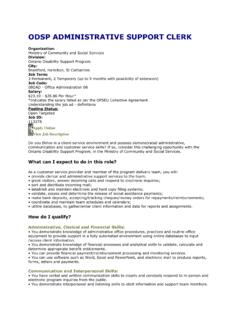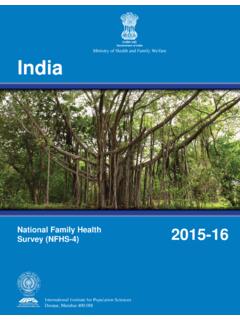Transcription of Anti-oppression in child welfare laying the foundation for ...
1 Anti-oppression IN child welfare : laying THE foundation FOR CHANGE AAA DDDiiissscccuuussssssiiiooonnn PPPaaapppeeerrr Prepared by: The child welfare Anti-oppression Roundtable October 2008 2 Anti-oppressive practice is concerned with eradicating social injustice perpetuated by societal structural inequalities, particularly along the lines of race, gender, sexual orientation and identity, ability, age, class, occupation, and social service usage. Gary C. Dumbrill School of Social Work McMaster University 3 Acknowledgements This discussion paper is the result of much work and many discussions, by many people. It aims to challenge our collective assumptions, shine a new lens on our thinking and create the beginning of a shared vision for moving the delivery of Ontario child welfare services into an Anti-oppression framework.
2 The following members of the child welfare Anti-oppression Roundtable contributed in various ways to the development of this paper: Meeta Bains Cris Calley Jones Sheryl Cohen Schecter Sue Dale Sharon Evans Bernie Finnigan Bernadette Gallagher Shelley Garratt Deb Gollnick Lorna Grant Inderjit Grewal Christian Hackbusch Robin Lelievre Nicola Jones Daniel Kikulwe Heidi Kiang Elizabeth Molligan Kike Ojo Sharron Richards Sally Rivers Jean Samuel Marna Shecter Arijana Tomicic Samantha Veniez Regina Whelan We also thank student Steven Jack from Ryerson University for his research contribution and acknowledge our appreciation to Simcoe Children s Aid Society for their support in printing this document.
3 We acknowledge the absence of several critical voices in this preliminary discussion paper: child welfare services users and aboriginal colleagues. We also recognize the absence of a francophone perspective. It is our intention to use the consultation process to continue to invite these perspectives into the dialogue. The paper was compiled and edited by: Lorna Grant 4 Kike Ojo Anti-oppression in child welfare : laying the foundation for Change A Discussion Paper CONTENTS PAGE I. 5 A. Background B. Anti-oppression & Other Provincial Initiatives C. The Purpose of This Paper II. Definitions and 7 III. Anti-oppression & child 8 A. The Context B. The System C.
4 Why Now? IV. Operationalizing Anti-oppression in child welfare : Critical Considerations .. 11 A. The Role of Leadership B. Organizational Preparation for Change C. Accountability D. Resources and Sustainability V. What Next? Creating an Anti-oppression Framework for child welfare Systems, Structures and 15 VI. Discussion 16 References and Selected 17 Appendixes A. Glossary of 21 B. child welfare Anti-oppression Roundtable Membership, September 2008 .. 26 C. Agency Examples Policy: Children s Aid Society of Toronto .. 27 Position Paper: Children s Aid Society of Brant .. 39 Committee Terms of Reference: Simcoe County Children s Aid Society.
5 53 D. child welfare : AOP s Nemesis? Gary C. Dumbrill, School of Social Work McMaster University (2003). Article reprinted with 56 5 INTRODUCTION A. Background The child welfare Anti-oppression Roundtable evolved from a 2004 initiative through which a sub-committee of the Provincial Inter-Agency child welfare Training Committee was created to develop a training curriculum to assist front-line staff in responding to diversity. Over time, it became apparent that training alone could not overcome the systemic oppression that continues to lead to the over-representation of racialized and marginalized populations within the child welfare system.
6 The objectives of the sub-committee evolved and led to: the expansion of the Anti-oppression curriculum and training to address relationships with agency staff as well as with service users; and, the creation of the provincial Anti-oppression Roundtable to develop, support and share initiatives in Anti-oppression work. Seven agencies (Toronto, Toronto Catholic, Hamilton, Wellington, Waterloo, Ottawa and Peel) underwrote the costs of the development of the Anti-oppression curriculum, including the development of 13 trainers. Workshop pilots began in April 2008 and have already been delivered to several hundred staff. Following feedback and modifications, a plan will be developed to support delivery of the training throughout the province.
7 The Anti-oppression Roundtable now includes representation from almost half of the child welfare agencies in Ontario (see Appendix A). It aims to develop and recommend a strategy to build agency capacity and advocate for the inclusion of anti-oppressive principles in policies, structure, practices and relationships with both internal and external stakeholders. The Roundtable will be seeking formal status through the Local Directors Section and requesting funds from the Provincial Projects Committee to support a consultation process leading to the approval of an Anti-oppression framework for child welfare in Ontario. This paper is an invitation to the field to join the discussion and commit to action.
8 Throughout this same period, a number of agencies have individually begun the process of integrating practices that align with the principles of Anti-oppression . We recognize and will continue to benefit from their efforts. B. Anti-oppression & Other Provincial Initiatives This discussion about Anti-oppression has been influenced and enriched by several other provincial initiatives. In 2001, the Provincial Directors of Service published a paper, A Critical Analysis of the Evolution of Reform , which called for a rebalancing of priorities to enable a viable, client-centred protection service . This challenge led to a project which aimed to identify best practices and required skills to enhance positive worker interventions with children and their families in child protection services.
9 The results of this project, led by Andy Koster, were published in 2005 as child 6 welfare in Ontario: Developing a Collaborative Intervention Model . The consultation materials included 20 documents related to advocacy approaches to work for social justice, including Anti-oppression work. Also in 2005, the Provincial Directors of Service published a paper, Changing the Picture: Succession Planning and Gender Participation which identified the barriers that perpetuate the under-representation of women at the senior levels of child welfare . At the same time, the Ministry of Children & Youth Services, through the child welfare Secretariat, launched a process that led to a legislative and policy framework designed to transform child welfare service delivery in Ontario.
10 Fundamental to this transformation was recognition of the need to work in partnership with service users and to recognize their unique and increasingly complex needs. C. The Purpose of This Discussion Paper In 2007, members of the Anti-oppression Roundtable began to consider how to broaden the dialogue about Anti-oppression in child welfare and engage the field to act. This discussion paper is the result of these deliberations. Its purpose is twofold: to provide a summary of the current thinking about Anti-oppression and its relevance to child welfare ; and, to stimulate a provincial dialogue and consultation process that will result in the creation of a shared framework for Anti-oppression in all Ontario child welfare agencies.

















![Gender Equality and Women's Empowerment in India [OD57]](/cache/preview/0/7/f/d/9/7/1/6/thumb-07fd97166dd92c7359501888c42037d3.jpg)
